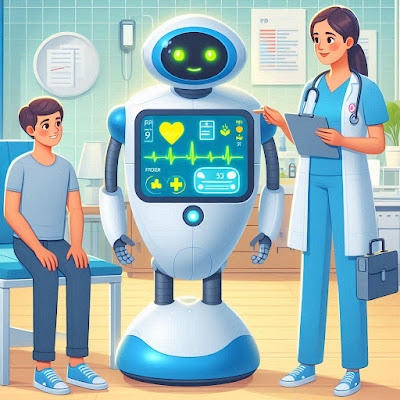Introduction: The Promise of Healthcare Robotics
In recent years, healthcare robotics has emerged as a disruptive force in the field of medicine, revolutionizing the way healthcare is delivered, procedures are performed, and patients are treated. From surgical robots and robotic exoskeletons to assistive robots and telepresence devices, the applications of robotics in healthcare are vast and diverse. In this comprehensive blog post, we'll explore the latest advancements in healthcare robotics, their potential to transform patient care, and the challenges and considerations associated with their adoption.
 |
| Healthcare Robotics |
Understanding Healthcare Robotics: From Science Fiction to Reality
Healthcare robotics encompasses a wide range of robotic systems, devices, and technologies designed to assist healthcare professionals in various clinical and non-clinical tasks. These include:
Surgical Robots: Robotic surgical systems, such as the da Vinci Surgical System, enable surgeons to perform minimally invasive procedures with enhanced precision, dexterity, and visualization. These systems utilize robotic arms equipped with surgical instruments and cameras, allowing surgeons to operate with greater accuracy and control.
Rehabilitation Robots: Robotic exoskeletons and assistive devices are used in rehabilitation settings to help patients regain mobility, strength, and function following injury or illness. These devices provide personalized, intensive therapy and assistance to individuals with neurological disorders, spinal cord injuries, or musculoskeletal conditions.
Assistive Robots: Assistive robots, such as robotic companions and personal care robots, support individuals with disabilities or age-related limitations in performing daily activities, managing medications, and monitoring health parameters. These robots provide companionship, assistance, and peace of mind to users and their caregivers.
Telepresence Robots: Telepresence robots allow healthcare providers to remotely interact with patients, conduct consultations, and participate in clinical rounds from a distance. Equipped with cameras, microphones, and screens, these robots enable real-time communication and collaboration between healthcare professionals and patients or colleagues.
The Benefits of Healthcare Robotics: Enhancing Patient Care and Outcomes
Healthcare robotics offers a multitude of benefits for patients, healthcare professionals, and healthcare organizations:
Precision and Accuracy: Robotic systems enable precise, accurate, and reproducible actions, reducing the risk of human error and improving clinical outcomes. In surgical settings, robotic assistance can enhance surgical precision, minimize tissue trauma, and shorten recovery times for patients.
Minimally Invasive Procedures: Robotic-assisted surgery allows for minimally invasive approaches to complex surgical procedures, resulting in smaller incisions, reduced blood loss, and faster recovery compared to traditional open surgery. Patients experience less pain, scarring, and postoperative complications, leading to improved quality of life.
Personalized Rehabilitation: Rehabilitation robots offer personalized, intensive therapy tailored to each patient's specific needs and abilities. These devices provide targeted assistance, feedback, and monitoring, helping patients achieve optimal functional recovery and regain independence in daily activities.
Remote Patient Monitoring: Telepresence robots facilitate remote patient monitoring and virtual care delivery, expanding access to healthcare services for individuals in rural or underserved areas. Healthcare providers can conduct virtual consultations, monitor patients' vital signs, and deliver interventions in real-time, improving access to timely and effective care.
Challenges and Considerations in Healthcare Robotics: Addressing Ethical, Legal, and Technical Issues
Despite the numerous benefits of healthcare robotics, their widespread adoption poses challenges and considerations that must be addressed:
Ethical and Legal Concerns: Ethical considerations surrounding patient consent, privacy, autonomy, and liability are paramount in healthcare robotics. Healthcare organizations must establish clear policies and guidelines for the use of robotic technologies, ensuring that patient rights and safety are protected.
Cost and Accessibility: The high cost of robotic systems and technologies may limit their accessibility and affordability for healthcare organizations, particularly in resource-constrained settings. Healthcare providers must carefully evaluate the cost-effectiveness and return on investment of robotic solutions to justify their implementation.
Human-Robot Interaction: Ensuring safe and effective human-robot interaction is essential to prevent accidents, errors, or adverse events. Robotic systems must be designed with intuitive interfaces, user-friendly controls, and fail-safe mechanisms to minimize the risk of harm to patients or operators.
Regulatory Oversight: Robotic medical devices are subject to regulatory oversight by agencies such as the U.S. Food and Drug Administration (FDA) to ensure their safety, efficacy, and compliance with quality standards. Healthcare organizations must navigate regulatory requirements and obtain necessary approvals before deploying robotic systems in clinical practice.
The Future of Healthcare Robotics: Advancing Innovation and Collaboration
As healthcare robotics continues to evolve, the future holds exciting possibilities for innovation, collaboration, and interdisciplinary research. Advancements in artificial intelligence, machine learning, and sensor technologies are driving the development of more sophisticated and adaptive robotic systems capable of autonomous decision-making and learning from human feedback. Collaboration between engineers, clinicians, researchers, and industry partners will be crucial to advancing the field of healthcare robotics and harnessing its full potential to improve patient care and outcomes.
Conclusion: Embracing the Robotic Revolution in Healthcare
In conclusion, healthcare robotics represents a paradigm shift in the delivery of healthcare, offering unprecedented opportunities to enhance patient care, improve clinical outcomes, and transform healthcare delivery models. From robotic surgery and rehabilitation to telepresence and assistive robotics, these technologies are reshaping the way healthcare is delivered, experienced, and perceived. As we embrace the robotic revolution in healthcare, it is essential to address the challenges and considerations associated with their adoption, ensuring that robotic technologies are deployed ethically, safely, and equitably to benefit patients and society as a whole.







